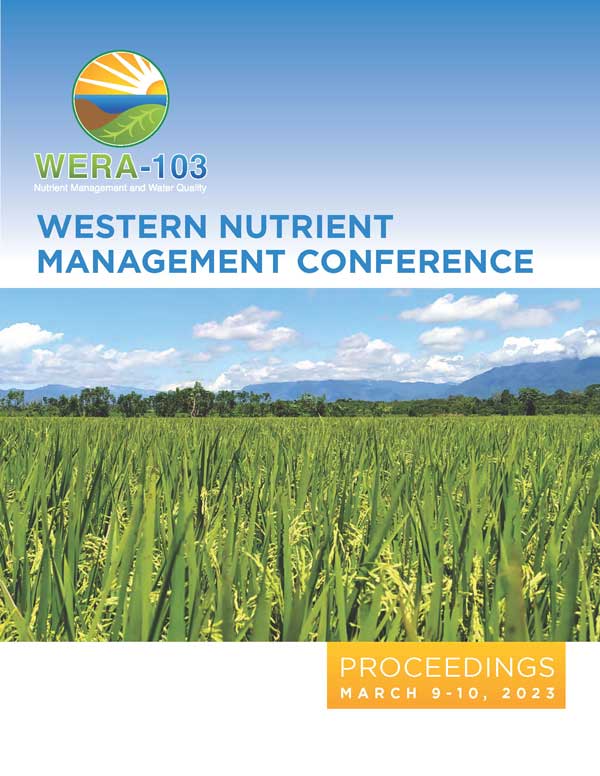Download the Conference Proceedings
Proceedings
Authors
| Filter results9 paper(s) found. |
|---|
1. Soil Health Changes Following Transition from an Annual Cropping to Perennial Management-Intensive Grazing AgroecosystemManagement-intensive Grazing (MiG) on irrigated, perennial pastures has steadily increased in the western US due to pressure for reducing public lands grazing, overall declining land available for pasture, and decreasing commodity prices. However, there are still many unknowns regarding MiG and its environmental impact, especially with regards to soil health. Over a two-year period, we studied changes in soil health under a full-scale, 82 ha pivot-irrigated perennial pasture system grazed with... J. Ippolito, C. Shawver, J. Brummer, J. Ahola, R. Rhoades |
2. Soil Management Assessment Framework Use for Identifying Soil Quality Changes in Irrigated AgricultureThe 820 km2 Twin Falls (Idaho) irrigation tract is part of the Natural Resources Conservation Service (NRCS) - Conservation Effects Assessment Project (CEAP). Furrow irrigation was initiated in the early 1900s but, since the 1990s, the NRCS Environmental Quality Incentives Program (EQIP) and other specialty projects have resulted in conversion of approximately 40% of the irrigation tract area to sprinkler irrigation. Most past CEAP research has focused on water quantity and quality, effects... J. Ippolito, D. Bjorneberg, D. Stott, D. Karlen |
3. Salt and Sediment Balances in an Irrigated Watershed in Southern IdahoThe quality of irrigation return flow in a 205,000 acre southern Idaho watershed has changed since 1970. Converting from furrow irrigation to sprinkler irrigation and installation of wetlands and sediment ponds have greatly reduced sediment loss. There is now more sediment in the irrigation water diverted into the watershed than returns to the Snake River (>100 lb a-1) compared to a net loss of 410 lb a-1 of sediment in 1971. There is also more soluble salt flowing into the watershed than... D. Bjorneberg, A. Koehn, J. Ippolito |
4. Soil Phosphorus Availability Differences Between Sprinkler and Furrow IrrigationWater flowing in irrigation furrows detaches and transports soil particles and subsequently nutrients such as phosphorus (P). To reduce the risk of erosion and offsite P transport, producers in south-central Idaho have been converting from furrow to sprinkler irrigation. We completed research on soil P dynamics in furrow versus sprinkler irrigated soils from four paired-fields in the region. Surface soils (0-2.5 inches) were obtained from fields in September following barley harvest. Furrow irrigated... J. Ippolito, D. Bjorneberg |
5. Soil Copper Thresholds for Potato ProductionA rising concern with the application of dairy wastes to agricultural fields is the accumulation of copper (Cu) in the soil. Copper sulfate (CuSO4) from cattle footbaths is washed out of dairy barns and into wastewater lagoons. The addition of CuSO4 baths on dairies can increase Cu concentration significantly in manure slurry. The Cu-enriched dairy waste is then applied to agricultural crops, thus raising concerns about how soils and plants are impacted by these Cu additions. Repeated applications... A. Moore, M. Satterwhite, J. Ippolito |
6. Biochar Usage: Pros and ConsSoil fertility benefits of charcoal application have been reported as early as 1847 indicating that plant nutrients are sorbed within charcoal pores. The use of biomass-derived black carbon or biochar, the solid byproduct from the pyrolysis processing of any organic feedstock, has garnered recent attention as a potential vehicle for carbon sequestration and a beneficial soil conditioner. However, most of the past biochar research has focused on improving the physico-chemical properties of tropical... R. Lentz, J. Ippolito, K. Spokas, J. Novak, H. Collins, J. Sterubel |
7. Influence of Dairy Manure Applications on Corn Nutrient UptakeCorn silage is the predominant crop in Idaho used for recovering phosphorus (P) that has accumulated in soils from dairy manure applications. However, little is known about how much phosphorus and other nutrients are being recovered under Idaho conditions. The objective of the study is to estimate phosphorus removal by irrigated corn silage crops cultivated throughout Southern Idaho with variable soil test P concentrations, and to identify effects of increasing soil test P on potassium (K), calcium... A. Moore, B. Brown, J. Ippolito, S. Hines, M. De haro marti, C. Falen, M. Chahine, T. Fife, R. Norell |
8. Reducing Dairy Effluent Phosphorus Content Through Struvite ProductionForced precipitation of struvite (magnesium ammonium phosphate hexahydrate, MgNH4PO46H2O) in wastewater treatment has recently received increased attention as a method of phosphorus (P) recycling. Dairy lagoon P concentrations can be lowered, and the recovered struvite has the potential to be marketed and used as a fertilizer. Struvite may even be useful in organic production on calcareous soils, where rock P (PR) is not an option. A new organic treatment method, based on an existing... J. G. davis, J. Ippolito, M. Massey, R. Sheffield |
9. Effects of Long-term Biosolids Applications in Two Dryland Agroecosystems on Physical, Biological, and Chemical Soil Health PropertiesBiosolids can be important sources of organic matter to semi-arid dryland grain systems and have the potential to mitigate some of the soil health challenges specific to these areas while providing an alternative to synthetic fertilizers. Biosolids are an important avenue for beneficially reusing and redistributing nutrients from high population urban areas to more rural agricultural areas. We explored how long-term (20+ year) applications of biosolids at two field sites affected physical, biological... M. Desjardins, A. Bary, J. Ippolito, S. Cappellazzi, D. Liptzin, D. Griffin-lahue |
